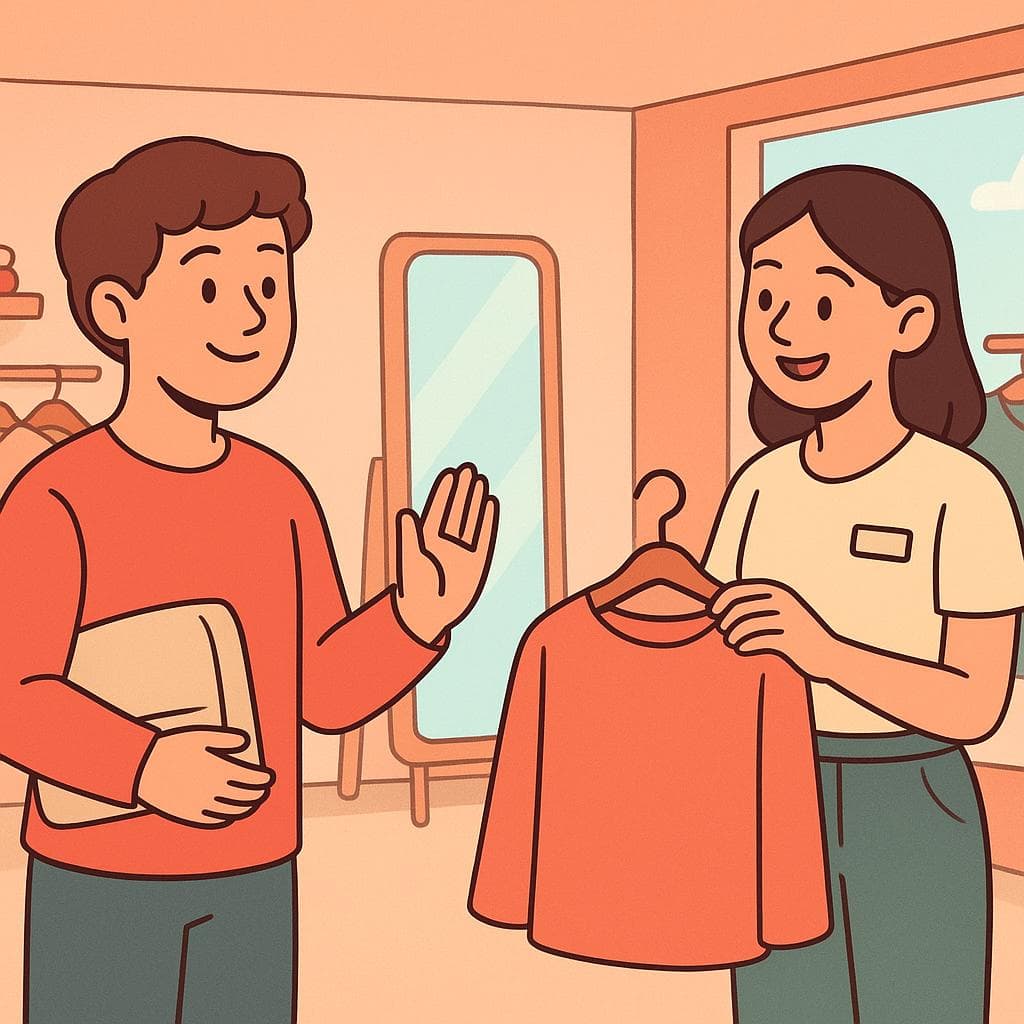I'm just looking
in SpanishSólo estoy mirando, gracias
/SOH-loh ehs-TOY mee-RAHN-doh, GRAH-see-ahs/
The most standard, polite, and effective way to tell a salesperson you are browsing and don't need help yet. Adding 'gracias' is essential for politeness.

A polite smile and 'sólo estoy mirando' is all you need to browse freely.
💬Other Ways to Say It
Sólo estoy mirando
/SOH-loh ehs-TOY mee-RAHN-doh/
The direct translation. It works everywhere, but adding 'gracias' at the end makes it softer.
Nada más estoy mirando
/NAH-dah mahs ehs-TOY mee-RAHN-doh/
Extremely common in Mexico and parts of Latin America. 'Nada más' means 'nothing more' or 'just' in this context.
Sólo estoy echando un vistazo
/SOH-loh ehs-TOY eh-CHAHN-doh oon vees-TAH-soh/
A very natural, idiomatic phrase used widely in Spain. It literally means 'I'm just casting a glance.'
Sólo estoy viendo
/SOH-loh ehs-TOY BYEHN-doh/
Uses the verb 'ver' (to see) instead of 'mirar' (to look). Very common in spoken Latin American Spanish.
Gracias, estoy bien
/GRAH-see-ahs, ehs-TOY byehn/
Means 'Thanks, I'm good.' It's an indirect way to say you don't need assistance without explicitly saying you are looking.
Sólo miro
/SOH-loh MEE-roh/
A shorter, present-tense version. Slightly more direct.
🔑Key Words
Key Words to learn:
📊Quick Comparison
Here is a quick guide to choosing the right phrase based on where you are and how casual you want to be.
| Phrase | Formality | Best For | Avoid When |
|---|---|---|---|
| Sólo estoy mirando | Neutral | Any situation, any country | Never (it's always safe) |
| Nada más estoy mirando | Casual | Mexico and Central America | In Spain (might sound slightly odd, though understood) |
| Estoy echando un vistazo | Neutral/Idiomatic | Spain | You want to be extremely brief |
📈Difficulty Level
Very straightforward. The only trick is the rolled 'r' in 'mirando', but a soft 'd' sound works for beginners.
Uses the standard present progressive (estar + -ando), which is very similar to English 'am -ing'.
The challenge isn't the words, but knowing how to politely deflect persistent sales culture in some regions.
Key Challenges:
- Remembering to add 'gracias' to sound polite
- Not confusing 'mirar' (browsing) with 'buscar' (hunting for something)
💡Examples in Action
No necesito ayuda, sólo estoy mirando, gracias.
I don't need help, I'm just looking, thank you.
Buenas tardes, sólo estoy echando un vistazo.
Good afternoon, I'm just taking a look around.
Gracias, pero nada más estoy viendo.
Thanks, but I'm just looking.
¿Puedo entrar sólo a mirar?
Can I come in just to look?
🌍Cultural Context
The 'Hovering' Salesperson
In many Latin American countries, customer service is extremely attentive. Salespeople may follow you closely or stand right next to you while you browse. This isn't suspicion; it's considered good service to be immediately available. Saying 'sólo estoy mirando' is the polite way to give yourself some space.
Greetings are Mandatory
Before you say you are 'just looking,' you must say hello. Walking into a small shop and ignoring the 'Buenos días' from the clerk is considered rude. Always reply to the greeting first, then use this phrase if they ask if you need help.
Directness in Spain
In Spain, service can be more hands-off compared to Latin America. You might not be approached as quickly, but if you are, the phrase 'estoy echando un vistazo' is the perfect local way to sound natural.
❌ Common Pitfalls
Confusing 'Mirar' and 'Buscar'
Mistake: "Saying 'Estoy buscando' (I'm searching/looking for) instead of 'Estoy mirando' (I'm looking at/watching)."
Correction: Sólo estoy mirando.
Forgetting the 'Gracias'
Mistake: "Saying just 'Estoy mirando' in a flat tone."
Correction: Estoy mirando, gracias.
Wrong 'To Be' Verb
Mistake: "Saying 'Soy mirando'."
Correction: Estoy mirando.
💡Pro Tips
Smile and Node
Body language is key. A smile and a small nod while saying this phrase shows you appreciate their job but want autonomy. It changes the tone from 'leave me alone' to 'I'm happily browsing.'
Use it as a Shield
In tourist areas where vendors can be aggressive, you can use this phrase while keeping walking. However, in open-air markets, sometimes a simple 'No, gracias' is more effective if you aren't actually interested in buying.
Re-engaging
If you use this phrase but later decide you do need help, make eye contact or say 'Disculpa' (Excuse me) to signal the salesperson back over. They will usually be keeping an eye on you anyway.
🗺️Regional Variations
Mexico
In Mexico, 'nada más' (literally 'nothing more') is the go-to phrase for 'just'. You will hear this constantly. Salespeople are also very polite and attentive here, so keep your tone warm.
Spain
Spaniards use the idiom 'echar un vistazo' (to cast a glance) very frequently. It sounds very native. Service is generally less hovering than in the Americas.
Argentina/Uruguay
Directness is common here. A simple 'Sólo miro' is perfectly acceptable.
💬What Comes Next?
After you say you are just looking
Cualquier cosa, estoy a la orden / Avísame si necesitas algo
Anything you need, I'm at your service / Let me know if you need anything
Muy amable, gracias
Very kind, thank you
If you decide you actually do need help
¿Encontró lo que buscaba?
Did you find what you were looking for?
De hecho, busco una camisa azul
Actually, I'm looking for a blue shirt
🧠Memory Tricks
The word 'Mirando' sounds like 'Mirror'. When you shop, you often look in the mirror. So, 'Mirando' = Looking.
The Spanish word 'Sólo' (or Solo) is easy because it means the same thing as the English concept of 'going solo'—you want to do it alone (just you).
🔄How It Differs from English
In English, 'I'm just looking' can sometimes be said while walking away or ignoring the clerk. In Spanish culture, because the interaction often starts with a greeting, you usually have to stop, acknowledge the person, say the phrase, and smile before returning to browsing. It is slightly more relational.
Spanish is generally more polite/indirect in retail. A blunt 'No' to 'Can I help you?' is ruder than 'Sólo estoy mirando, gracias'.
False Friends & Common Confusions:
Why it's different: English speakers often swap 'looking' and 'searching'. In Spanish, 'Buscar' (search) signals you have a goal, while 'Mirar' (look) signals you are browsing.
Use instead: Use 'Mirar' for browsing, 'Buscar' only if you want to ask for a specific item.
🎯Your Learning Path
➡️ Learn Next:
How to ask 'How much is this?'
Once you finish looking and find something you like, you'll need to ask the price.
How to say 'I'll take it'
The natural conclusion to a successful shopping trip.
Clothing vocabulary in Spanish
Learn the names of the specific items you are looking at.
✏️Test Your Knowledge
💡 Quick Quiz: I'm just looking
Question 1 of 3
A shop assistant approaches you and asks '¿Le puedo ayudar en algo?' (Can I help you with anything?). You want to browse on your own. What do you say?
Frequently Asked Questions
Is it rude to say 'no' to a shop assistant in Spanish?
It can be if you just say a blunt 'No.' It is much better to say 'No, gracias, sólo estoy mirando.' The explanation that you are browsing softens the refusal of help.
Can I use 'Solo estoy viendo' instead of 'mirando'?
Yes, absolutely. 'Viendo' (seeing) and 'Mirando' (looking) are often used interchangeably in Latin America for shopping contexts. 'Viendo' is slightly more casual.
Do I need to use the word 'Yo' (I) at the start?
No. In Spanish, the verb 'Estoy' already includes the 'I' subject. Saying 'Yo sólo estoy mirando' is not wrong, but it sounds less natural and slightly emphatic. It's better to drop the 'Yo'.
What if I actually want to try something on?
Then you would say 'Me gustaría probarme esto' (I would like to try this on) or '¿Puedo probarme esto?' (Can I try this on?).
📚Continue Learning Spanish Phrases
Explore More Phrases in These Categories
Find similar phrases to expand your Spanish vocabulary:
Want to Learn More Spanish Phrases?
Browse our complete collection of Spanish phrases organized by situation, from basic greetings to advanced conversations. Perfect for travelers, students, and anyone learning Spanish.
View All Spanish Phrases →



